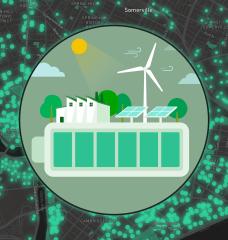
In today’s increasingly interconnected world, where trillions of dollars’ worth of goods and services are traded annually, greening trade is not only an opportunity, it is imperative. If we are to reverse the global decline of biodiversity, mitigate the release of greenhouse gases (GHG), halt the degradation of lands, and protect our oceans, then international trade must become sustainable and responsible.
This is precisely what world leaders envisioned at the Rio+20 conference in June 2012. They reaffirmed “international trade [as] an engine for development and sustained economic growth”, and identified the green economy as “an important tool for achieving sustainable development”. Developing countries, in particular, are likely to benefit from implementing green economy policies that scale up sustainable trade and mitigate climate borne disasters.
Green Economy and International Trade
Trade, when accompanied by appropriate regulation, can facilitate the transition to a green economy by fostering the exchange of environmentally friendly goods and services (including environmentally sound technologies) and by increasing resource efficiency and generating economic opportunities and employment. In order to contribute to GHG elimination, the additional wealth generated by international trade should provide prudent technological adoption to reduce climate changes, rather than exacerbate them.
The transition to a green economy, in turn, has the potential to create enhanced trade opportunities by opening new export markets for environmental goods and services, by increasing trade in products certified for sustainability and promoting certification-related services, and by greening international supply chains. The adoption of more resource- and energy-efficient production methods as part of green economy measures has an important role to play in securing access to and long-term competitiveness in protecting the climatic changes, especially in the developing countries.
The meeting of global environmental leaders at Rio+20 has initiated a shift of focus, from the potential risk of trade protectionism associated with green economy policies, towards improving the trade performance of developing countries as an additional effect of, and motivation for, the implementation of green economy policies. As a result, a green economy is increasingly seen as a gateway to new opportunities for trade, growth and sustainable development.
Yet, while a shift to more sustainable trade practices may reduce climate changes and related disasters, achieving such a shift will also require effective policies to mitigate the adverse impacts that often arise from technological misuse, fraudulent political agendas, geopolitical traps, bureaucratic red tapes, uneven economic barriers, and social marginalization. Addressing these effects including reducing income inequalities and improving the livelihoods of local populations, as well as using environmentally sound technologies and processes are key elements for improving the sustainability of international trade and halting climate changes.
Current Global Trends
Trade is a vital element of the global economy as well as protecting the mother world from any manmade and natural calamities. The sum of world exports of goods and commercial services amounted to US$ 22.3 trillion at the end of 2010, growing at an average 5% rate per year between 2000 and 2011. In addition, merchandise and commercial services exports provide an increasingly important share of world GDP – rising from 14% in 1970 to 29.3% in 2011. In developing countries, this share reached peaks of 45% before the financial and economic crisis of 2008. In addition, trade between developing countries, or “South-South” trade, has recently been assessed as the most dynamic segment of global trade in the last decade, increasing from 39.2% of total developing country exports in 2002 to 50% in 2010.
While creating economic growth, increasing volumes of trade have also put additional stress on natural resources and increased GHG emissions. Increased demands by emerging economies for natural resources, coupled with the already unsustainable levels of resource consumption and use registered in more developed countries, led to an unprecedented surge in resource consumption and trade in the period 1995-2010. In addition, a trade-driven expansion in the scale of production and transport has resulted in significant increases in GHG emissions. Emissions from international airtime and aviation transport, for example, have increased by 88% over a period of 25 years.
World trade patterns show that the least developed countries’ exports are still dominated by natural resource-based products and raw materials. Many developing countries, and particularly the least developed ones, are faced with an urgent need to diversify their economies and move towards more sustainable practices. In the past fifteen years, pressure on natural resources, largely driven by international demand, has escalated and resulted (with very few exceptions) in detrimental environmental and social impacts, such as biodiversity loss, environmental degradation, and inequitable income distribution.
Opportunities to counter these trends can be found in the growth of existing sustainable trade markets and in the opening of new markets for green goods and services. These markets grow faster than conventional markets. Pioneering producers, service providers, and exporters are already taking advantage of new trade opportunities driven by increasing consumer awareness and more sustainable consumption and production patterns. Developing countries with abundant natural capital, as well as competitive production costs and human capital, have, in some cases, a comparative advantage for capturing these opportunities.
Sustainable trade practices – such as trade-in certified products or in environmental goods and services – are on the rise in absolute terms. There is, indeed, an important move towards mainstreaming sustainability in production and trade at the global level. However, it is important to note that sustainable trade practices currently represent only a small fraction of total trade.
The transfer of environmentally sound technologies, through trade- and investment-related channels, is also promoting economic and social development in developing countries. These channels allow the results of investments in research and development (R&D) to benefit a larger number of producers and consumers while facilitating natural resource protection and climate change mitigation and adaptation efforts. At the same time, it remains crucial for developing countries to build or reinforce R&D capacity, particularly related to environmentally sound technologies. In addition, technological advancements and spillovers facilitated by international trade can lead to further specialization in the production of more energy- and resource-efficient goods and services – which can ultimately reduce climate borne disasters.
Environment and Trade Linkages
These environmental and economic trends are not isolated; rather, they are fundamentally related. Much environmental damage is due to the increased scale of global economic activity. International trade constitutes a growing portion of global economic activity, making it an increasingly important driver of environmental change. As economic globalization proceeds and the global nature of many environmental problems become more evident, there is bound to be friction among the multilateral, national and regional systems of law and policy governing both.
There are intricate physical, legal, and institutional linkages between international trade and the environment. Trade linkages provide options for adopting modernized urban infrastructure and resilient innovations, i.e., energy technology challenges, adaptive solutions for grid optimization, and municipal restructuring. It is also elemental to re-positioning industrial plants in satellite towns with easy remote access to raw materials and human resources. For effective functioning, factors of community engagement, i.e., policy, funding, commerce, inclusion, and governance are also necessary. It is also fundamental to integrate digital capabilities, i.e., smart mobility and smart transit.
Two fundamental truths about this relationship should become clear in the process:
- The links between trade and the environment are multiple, complex, and important.
- Trade liberalization as such is neither good nor bad for the environment. Its effects on the environment depend on the extent to which environment and trade goals can be made complementary and mutually supportive. A positive outcome requires appropriate supporting social, economic, and environmental policies at national and international levels.
At the most basic level, trade and the environment are related because all economic activity is based on the environment. Natural resources such as metals & minerals, soil, forests, and fisheries are basic inputs to the production of any goods, and also provide the energy needed to process them. At the end of the cycle, the environment also receives the waste products of economic activity. Trade is also affected by the environment in many ways, from issues related to natural resource quality, safety, and availability to the fact that exporters must respond to growing consumer and regulatory demands for greener goods and services.
From another perspective, the environment and trade represent two distinct bodies of law and policy. Environmental law is embodied in various Multilateral Environmental Agreements (MEAs) and as regional, national and sub-national regulations. Trade law is embodied in such legal structures as the multilateral trade agreements under the World Trade Organization (WTO), and in regional and bilateral trade agreements. It is inevitable that these two areas of law and policy interact frequently. Environmental law, both national and international, and environmental policies—such as the promotion of renewable energy, environmental taxation, and conservation measures—help define how countries will structure their economic activities.
Trade law affects the way in which countries design their laws and policies in areas—such as subsidies, technical regulations, investment policy, and taxes—that are integral to environmental policies. Trade law and policy are increasingly more than just what happens at the multilateral level, however, with the explosive growth of regional and bilateral trade and investment agreements.
Finally, some issues are crosscutting in nature. Efforts to build capacity to participate meaningfully in the green economy, for example, take place on a number of levels. Two key avenues for this sort of work are: I) Aid for Trade, II) Trade Facilitation.
Emerging Opportunities
The intricate relationship between international trade, green economy, and mitigating climate changes revolve around emerging opportunities and persistent challenges in six economic sectors of particular interest for developing countries: agriculture, fisheries, forestry, manufacturing, renewable energy, and tourism. The following subsections provide a very brief summary of the opportunities that green economy policies generate for sustainable trade, and the incentives that international trade can create to advance a greener economy and act as a blueprint for tackling climate changes.
Agricultural
- The future of agriculture is threatened by a series of adverse environmental outcomes, including the continuing loss of biodiversity and ecosystem services, depletion and erosion of topsoil nutrients, increasing scarcity of freshwater, aggravated water pollution caused by poor nutrient management, hazardous chemical release, disposal, emissions and waste, and rising GHG emissions. Whereas trade conducted on a business-as-usual (BAU) scenario largely exacerbates these trends, sustainable trade has the potential to maintain or increase agricultural output in the medium- and long-term while reducing resource use, preserving the natural environment and promoting food safety.
- Sustainable farming methods can increase productivity, facilitate access to international supply chains, and respond to the rising global demand for more sustainable and organic produce. Many large multinational companies have also made sustainability commitments, which will have an impact on the business choices of upstream supply chain partners. In addition, the global market for organic food and beverages is projected to grow to US$ 105 billion by 2015, from the total value of US$ 62.9 billion in 2011. The production of tea in line with sustainability standards, for example, has grown by more than 3,000% between 2005 and 2018.
Fisheries & Aquaculture
- Globally, fish and fish products are the most extensively traded food commodity, and exports have expanded greatly over the past 35 years, rising from US$ 8 billion in 1976 to an estimated US$ 360 billion in 2018. 80% of world fish resources are overexploited or at their biological limit, and the top ten commercial species are still being harvested far beyond science-based sustainability levels. While a reduction of fishing effort remains a necessity, increased trade in fish and fish products certified for sustainability can improve the overall fisheries management systems, while increasing productivity of the resource and adding value to final products.
- Increased export revenues can arise from the sustainable management of wild-capture fisheries, including through certification. The sale of certified fish products in markets in developed countries and, increasingly, in some developing countries has changed from a niche market to a mainstream one. Trade opportunities for sustainably produced fish can create incentives for better management and capture some of the lost revenue of poorly managed fisheries, which are globally estimated at US$ 50 billion annually.
- In aquaculture, global demand for seafood that has been farmed in line with organic and/or broader sustainability standards has grown steadily in the last 15 years. Currently, aquaculture production that has been certified against various types of sustainability standards is estimated to cover 5% of total production. In the aquaculture sector, the total value of the demand for seafood that has been farmed according to certified sustainability standards is forecasted to increase from US$ 300 million in 2008 to US$ 1.95 billion by 2018.
Forestry
- The world’s forested area is declining and pressures on forests are expected to continue. Underlying this deforestation trend is weak governance, including lack of forest law enforcement, corruption, and bribery. Worldwide, the economic value of global illegal logging, including processing, is estimated to be worth between US$ 30-100 billion per year. More sustainable trade in timber and non-timber forest products can significantly increase transparency and ensure traceability in the forestry sector, in particular through certification schemes.
- Sustainable forest management, including through certification, has the potential to expand the relative share of trade in sustainable wood products and non-timber forest products. As of early 2013, the total area of certified forest worldwide stands at close to 400 million hectares, amounting to approximately 10% of global forest resources. Sales of certified products are worth over US$ 20 billion per annum. Depending on the operation, price premiums for certified wood, particularly from the tropics, can range from 15 to 25%. In addition, non-timber forest products fit niche trading strategies, particularly those that have a long shelf life, a high per-unit value, and are simple to process, store and handle without major investments. Developing countries are also selling forest carbon offsets in international markets, including through international mechanisms such as the Clean Development Mechanism and REDD+ (Reducing Emissions from Deforestation and Forest Degradation (REDD+) is a set of policy approaches and positive incentives designed to reward developing countries for strengthening the mitigation potential in forests).
Manufacturing Sector
- Manufacturing is energy- and resource-intensive. The sector is responsible for around 35% of global electricity use, over 20% of global CO2 emissions, and more than 25% of primary resource extraction. Furthermore, poisonings from industrial and agricultural chemicals are among the top five leading causes of death worldwide. Without decoupling natural resource use and environmental impacts from economic growth, as well as mainstreaming sustainability in global supply chains, growing international demand, trade and investment flows exacerbate the negative impacts connected to the growth of the sector.
- Products with environmentally friendly designs and companies that comply with sustainability standards for products and processes have an advantage in international markets. Many suppliers are rendering their practices more sustainable in order to secure their positions within international supply chains. This is illustrated for example by the 2,200% increase in global ISO 14001 certifications on environmental management awarded between 1999 and 2019. In addition, some developing countries are taking the lead in investing in sustainable manufacturing practices (e.g., remanufacturing) and products with an environmentally friendly design (e.g., eco-labeled textiles and energy-efficient electronics).
Renewable Energy Sector
- Renewable energy resources can address many of the challenges faced by conventional energy today. While 20% of the world population lacks access to electricity, energy from fossil fuel combustion caused global CO2 emissions to increase to a record high of 31.6 gigatonnes in 2011, estimated to further increase to 37 gigatonnes by 2035. The promotion of renewable energy can decisively limit carbon emissions from energy use, bearing the potential to save an equivalent of 220-560 gigatonnes of CO2 between 2010 and 2050. In addition, the production of and trade in energy from renewable sources can increase access to clean and cheap electricity and fuel but need to account for potential environmental and social adverse effects.
- The global market in low-carbon and energy-efficient technologies, which include renewable energy supply products, is projected to nearly triple to US$ 2.2 trillion by 2020. Even though their industrial policies have sometimes raised controversies, developing countries have significantly increased their exports of renewable energy equipment such as solar panels, wind turbines, and solar water heaters. In the solar sector, China has exported over US$ 10 billion worth in solar panels and cells, almost 80 times the value it exported only 10 years earlier. Apart from exporting components of new technologies, several developing countries are also expanding their potential to export electricity from renewable sources.
Tourism
- Tourism, as a major export sector, has a large potential to harness new opportunities by proactively addressing environmental and social impacts. In 2012, for the first time, the number of international tourists reached over one billion. Yet the tourism sector largely contributes to CO2 emissions, water, and air pollution, increased pressure on waste management, biodiversity loss, and potential conflicts with the social, economic, and cultural interests of local communities. The economic potential of sustainable tourism activities, particularly for developing countries, depends directly on the ability of countries to preserve their natural environments, as environmental degradation erodes the attractiveness of tourism destinations. As a consequence, sustainable and certified tourism activities can be a driver in reducing potentially negative environmental and social impacts of tourism, while increasing the attractiveness and the economic value of existing or potential destinations.
- The fastest-growing sub-sector in sustainable tourism is ecotourism, which focuses on nature-based activities. Many developing countries appear to have a comparative advantage in ecotourism, due to their natural environments, cultural heritage, and opportunities for adventure holidays. In addition, certification in the tourism sector is also experiencing increasing trends, as many tourism structures and sites recognize the attractiveness and potential price premiums that may follow the achievement of sustainability certification. Protected areas in Costa Rica, for example, receive more than one million visitors each year, generating entrance-fee revenues of over US$ 5 million, while Mexico’s protected areas record 14 million visitors per year, creating more than 25,000 jobs.
Addressing Challenges
Even when there is a strong economic, environmental, and social case for investing in greening trade, a number of important obstacles remain still. These relate mostly to limitations in financial and human resources, weak regulatory frameworks, lack of enforcement mechanisms, and poor economic infrastructure. Illiteracy as well as limited access to energy, for example, are key barriers to the further development of sustainable and certified trade. These issues need to be addressed through concerted efforts at the international, regional, national, and local community levels.
In addition, reducing trade-related emissions is another key challenge for achieving more sustainable trade and mitigating climate change. Hence, the transition to a greener economy will necessitate greater fuel efficiency in the transport sector and the use of alternative energy sources across all sectors as part of wider domestic, regional and global measures. The development of new markets in carbon credits and carbon offsets may also offer additional opportunities to reduce emissions and increase revenues.
Clearly, the ambitions and potential green economy strategies vary significantly based on a country’s circumstances, natural resources as well as political and economic conditions. Generally, however, the enabling conditions required for greater coherence between green economy policies and trade opportunities encompass:
Investment and Spending: Public investments in key economic infrastructure, technical assistance, targeted education programs, and access to sustainable resources, such as electricity from renewable energy sources, are crucial for increasing the success rate of developing country suppliers in accessing greener international markets.
Market-based instruments: The gradual elimination of subsidies that encourage unsustainable production and trade – in particular, fossil fuel, agricultural, and fisheries subsidies – and the introduction of pricing policies that take fully into account environmental and social costs of production and consumption are essential pre-conditions for enabling sustainable trade. Further, creating incentives for effective supply chain partnerships with international exporters promoting sustainability would particularly benefit small producers.
National Regulatory Frameworks: Policies and actions to support the greening of industries need to be incorporated into national sustainable development strategies and overarching legal frameworks. Strategies that more specifically address the greening of industries, such as national sustainable consumption and production plans, green procurement programs, and sector- and issue-based approaches, such as resource use, safe waste disposal, energy, education, and health & safety are also important policy tools.
International Frameworks: The rules-based multilateral trading system provides transparency and predictability for promoting the trade-related aspects of a green economy. The development of new multilateral rules under WTO, for example on fisheries subsidies, as well as further liberalization of trade in environmental goods and services, provide opportunities for effective collective actions to solve global problems. Furthermore, regional trade agreements, if properly designed, can offer important opportunities to promote sustainable practices and be a driver of policy reforms, increased capacity development, strengthened environmental regulation and better cooperation among relevant ministries. MEAs have a critical role to play in ensuring also the mutual supportiveness of the green economy and sustainable trade.
Dialogue and Capacity Building: Regulatory cooperation and capacity-building are amongst the most important means to overcome challenges in a proactive manner. Scaling up support for developing countries to harness green export opportunities requires coherent support from international governmental organizations – including UN agencies, MEAs, and the WTO – as well as the private sector and NGOs. South-South cooperation is also essential to support developing countries seeking to sustain and deepen their participation in international trade for sustainable goods and services. In this context, a key challenge is to inter-connect producers in developing countries and to link them to regional and global markets.
Conclusion
There are positive signs that trade-related practices are moving towards more environmental, social and economic sustainability. These trends have to be encouraged as well as fully informed by the Rio+20 mandate to advance the green economy in the context of stopping climate change sustainably.
Overall, as shown in this paper, trade in environmental goods and services including the implementation of sustainability standards, and the greening of global value chains can directly benefit the world by limiting climate changes and environmental disasters. Economic gains and climate control can be achieved by making trade more socially and environmentally sustainable. Indeed, there are clear instances where the opportunities to increase revenues through trade fully coincide with the objectives of a green economy. However, given the current limited application of sustainable trade in the context of climate control and limiting associated vulnerabilities, there is a need to significantly scale-up and expand capacity-building efforts to both harness existing opportunities in trade facilitation and create new ones. A meaningful transition to a greener economy strengthened by international trade will require extensive technical and financial support. A holistic approach comprising grass-root level engagement is the most crucial step to take. Citizen platforms, consumer bodies, and climate change advocates should be committed to assisting governments and other stakeholders in identifying and creating these sustainable trade opportunities and transforming risks and challenges into new pathways to tackle climate change. Further research, particularly focused on sustainable trade opportunities at the country level, is highly desirable and should be promoted by governments as well as the private sector.






